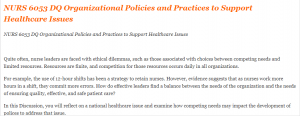NURS 6053 DQ Organizational Policies and Practices to Support Healthcare Issues
NURS 6053 DQ Organizational Policies and Practices to Support Healthcare Issues
NURS 6053 DQ Organizational Policies and Practices to Support Healthcare Issues
Quite often, nurse leaders are faced with ethical dilemmas, such as those associated with choices between competing needs and limited resources. Resources are finite, and competition for those resources occurs daily in all organizations.
For example, the use of 12-hour shifts has been a strategy to retain nurses. However, evidence suggests that as nurses work more hours in a shift, they commit more errors. How do effective leaders find a balance between the needs of the organization and the needs of ensuring quality, effective, and safe patient care?
In this , you will reflect on a national healthcare issue and examine how competing needs may impact the development of polices to address that issue.
To Prepare:
- Review the Resources and think about the national healthcare issue/stressor you previously selected for study in Module 1.
- Reflect on the competing needs in healthcare delivery as they pertain to the national healthcare issue/stressor you previously examined.
By Day 3 of Week 3
Post an explanation of how competing needs, such as the needs of the workforce, resources, and patients, may impact the

NURS 6053 DQ Organizational Policies and Practices to Support Healthcare Issues
development of policy. Then, describe any specific competing needs that may impact the you selected. What are the impacts, and how might policy address these competing needs? Be specific and provide examples.
By Day 6 of Week 3
Respond to at least two of your colleagues on two different days by providing additional thoughts about competing needs that may impact your colleagues’ selected issues, or additional ideas for applying policy to address the impacts described.
The healthcare environment is significantly growing and improving the quality of clinical services is essential. Healthcare policies and

NURS 6053 DQ Organizational Policies and Practices to Support Healthcare Issues
practices provide regulation in daily operation and ensure uniformity for all employees so that there are no discrepancies (Rosa et al., 2020). For a policy to be developed in nursing, the competing needs must align with the agenda the strategy is advocating for. Competing needs arise when the healthcare workers want to meet the set goals and objectives. For example, the workforce needs may be adequately addressed but the resources required are not sufficient enough to facilitate policy development (Anderson et al., 2020).
The competing needs that may impact the national healthcare issue/stressor under study in this discussion is the multi-morbidity. Multi-morbidity is steadily increasing across the world and poses a major challenge to healthcare systems around the world (Franklin et al., 2017). According to the healthcare providers, the reasons for the rise in multi-morbidity is lifestyle choices in which most Americans live a sedentary life, leading to obesity, cardiovascular disease, and diabetes. In Medicare population, 65% of patients have two or more chronic illnesses, therefore, Multi-morbidity is related to ageing and it is also socially patterned being common and occurring at an early age in areas of high socio-economic deficiency (Sacha et al., 2020).
To address the competing needs, the healthcare organization has to implement major changes in the workforce issue, managing patients, and distribution of resources (Figueroa et al., 2019). Managing chronic illnesses reduces the cost of healthcare because the rate of chronic diseases is higher especially in the US compared to other nations. The population affected by chronic illnesses requires special attention, therefore, the government should get sufficient nurses to help the people. Through the process of expansion of the affordable treatment programs, discouraging sedentary lifestyle, improving the medication adherence, and providing grants and funds to support healthcare, the health organization in America can play its role in the reduction health care cost (Crowley et al., 2020).
In conclusion, managing chronic illnesses, increasing resources, and advising people to live a healthy lifestyle leads to achieving the set goals in healthcare. Reduction in workforce can be achieved through gathering enough resources. Managing the competing needs have impacted before setting organizations policies and practices.
Submission and Grading Information
Grading Criteria
To access your rubric:
Week 3 Discussion Rubric
Post by Day 3 and Respond by Day 6 of Week 3
To participate in this Discussion:
Week 3 Discussion
Do you need a similar assignment written for you from scratch? We have qualified writers to help you.
You can rest assured of an A+ quality paper that is plagiarism free. Order now for a FREE first Assignment!
Use Discount Code "FREE" for a 100% Discount!
NB: We do not resell papers. Upon ordering, we write an original paper exclusively for you.

